Fannie Mae’s April economic forecast calls for multifamily housing starts to decline modestly through the end of 2025. Single-family housing starts are expected to rise but at a lower rate than predicted last month.
Fannie Mae’s forecasters are predicting that the Federal Reserve will leave the Fed Funds rate unchanged until Q4 2024, and then will cut twice to a rate of 5.0 percent by the end of the year. This is down from 3 cuts predicted for 2024 in last month’s forecast. However, they are still expecting the Fed Funds rate to fall to a level of 4.1 percent by the end of 2025.
Fewer multifamily starts expected
The current forecast for multifamily housing starts is shown in the first chart, below, along with three other recent forecasts. Fannie Mae considers any building containing more than one dwelling unit to be “multifamily”, including both condominiums and rental housing units.
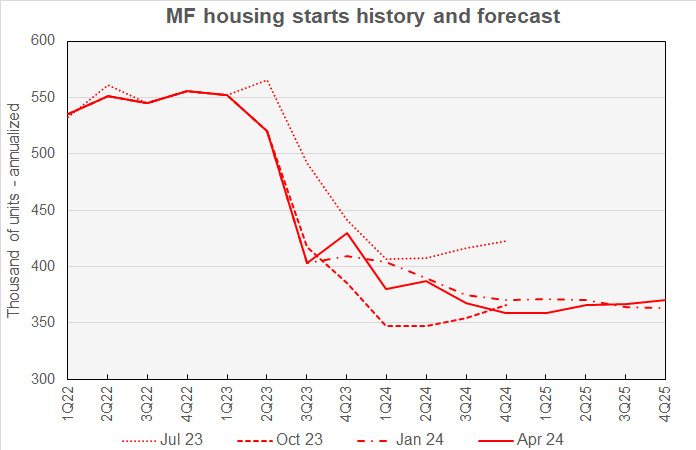
The multifamily starts forecasts were generally revised lower from last month’s levels. The number of starts forecast for the first quarter of 2024 and for the last quarter of 2025 were revised slightly higher. However, the forecasts for all of the quarters between were revised lower.
The current forecast calls for multifamily starts to fall from a high of 387,000 annualized units in Q2 2024 to a low of 359,000 annualized units in Q1 2025. Multifamily starts are then predicted to rise slowly through the end of 2025, finishing the year at a rate of 370,000 annualized units.
For reference, the most recent new residential construction report from the Census Bureau has multifamily starts running at an annualized rate of 346,000 units in Q1 2024.
Looking at yearly forecasts, the predicted number of multifamily starts for 2024 was revised lower by 7,000 units to 373,000 units. The forecast for multifamily starts in 2025 was also revised lower by 7,000 units to 365,000 units.
Single-family starts forecast revised higher
The current forecast for single-family housing starts is shown in the next chart, below, along with three other recent forecasts.
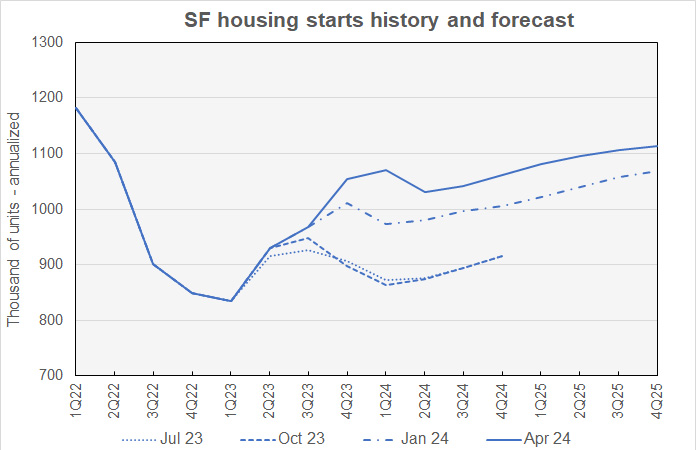
Every revision Fannie Mae’s forecasters made in this month’s forecast raised their estimate for the quarterly number of single-family starts expected. The revisions to the Q1 2024 forecast and to the forecasts for every quarter of 2025 were 60,000 or more annualized units higher. While the current forecast calls for a slight pullback in starts in Q2 2024, it sees starts growing through the rest of the forecast period, ending 2025 at an annualized rate of 1,113,000 units.
Fannie Mae now expects single-family starts to be 1,024,000 units in 2024, up 44,000 units from the level forecast last month. Single-family starts in 2025 are forecast to be 1,099,000 units, up 65,000 units from the level forecast last month.
Higher GDP growth expected
The next chart, below, shows Fannie Mae’s current forecast for Gross Domestic Product (GDP) growth, along with other recent forecasts.
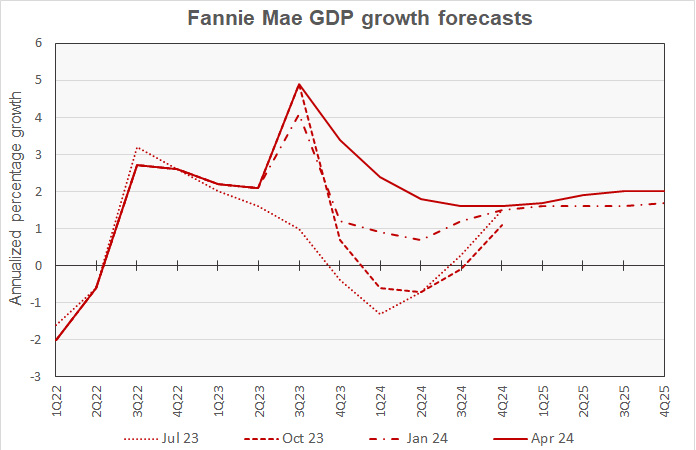
The revisions to the quarterly GDP estimates in this month’s forecast were relatively small, with no revision exceeding 0.2 percentage points. GDP growth in the Q2 2024 to Q3 2025 time span is expected to be marginally higher than predicted last month, but the rate of GDP growth at the end of 2025 is still expected to be 2.0 percent. The slowest GDP growth is now expected to be 1.6 percent, annualized, in Q4 2024.
The full year forecasts for GDP growth for 2024 and 2025 were each raised 0.1 percentage point to 1.8 percent and 1.9 percent respectively.
Higher CPI Inflation predicted
The next chart, below, shows Fannie Mae’s current forecast for the Consumer Price Index (CPI), along with three other recent forecasts.
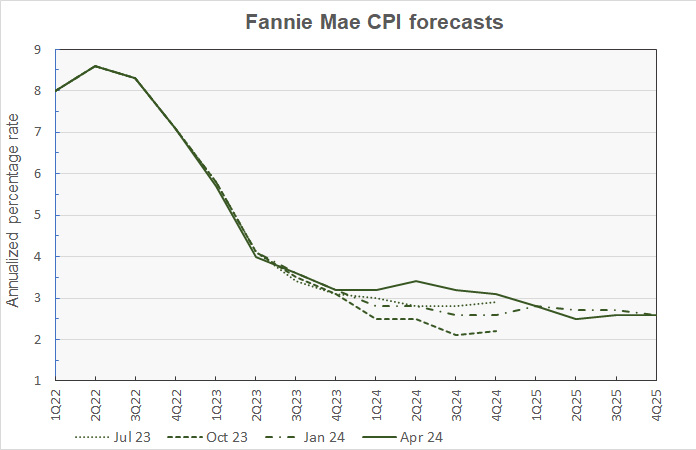
The revisions to Fannie Mae’s CPI inflation forecast were to the upside, particularly in 2024. Forecasts for Q2 and Q3 were each revised 0.6 percentage points higher to 3.2 percent and 3.1 percent respectively. While the year-over-year inflation rate is expected to fall as low as 2.5 percent in Q2 2025, it is forecast to edge upward to 2.6 percent by the end of the year.
Looking at whole-year forecasts, the forecast for year-over-year CPI inflation in Q4 2024 was raised 0.6 percentage points to 3.1 percent. The Q4 2025 year-over-year inflation forecast was left unchanged at 2.6 percent.
Employment forecast higher for 2024
The next chart, below, shows Fannie Mae’s current forecast for the employment growth, along with two earlier forecasts. Employment growth is our preferred employment metric since job gains, along with productivity gains, drive economic growth. By contrast, the unemployment rate depends on employment but also on the labor force participation rate. Either rising employment or falling labor force participation can drive the unemployment rate lower, but only the former would contribute to economic growth.
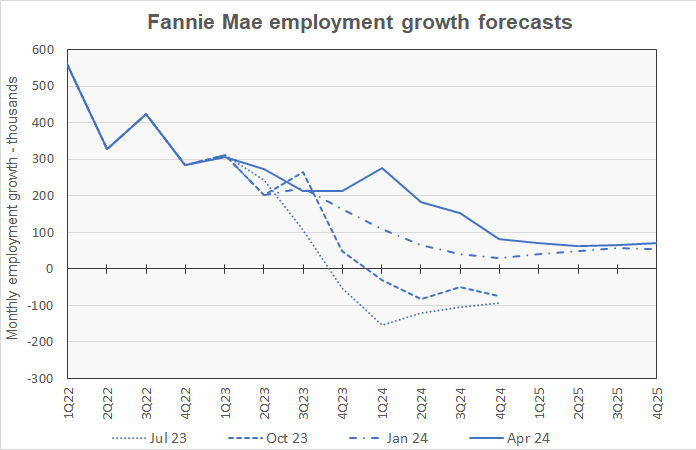
Fannie Mae foresees higher employment growth in 2024 than in earlier forecasts. Q1 2024 is predicted to have the strongest employment growth with an average monthly gain of 276,000 jobs. Q3 2024 is predicted to have the largest employment growth gain from that called for in last month’s forecast with an upward revision of 54,000 monthly job gains to an average of 153,000 new jobs per month.
Compared to last month’s forecast, the expected full year forecast for employment growth in 2024 was revised from a gain of 1,600,000 jobs to a gain of 2,100,000 jobs. The employment growth forecast for 2025 was lowered from gain of 900,000 jobs to a gain of 800,000 jobs.
The Fannie Mae April forecast can be found here. There are links on that page to the detailed forecasts and to the monthly commentary.










